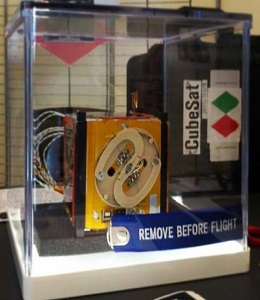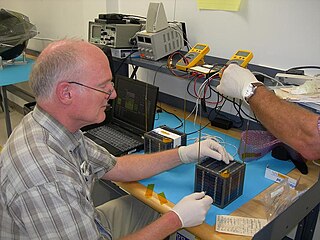
Aryabhata was India's first satellite, named after the famous Indian astronomer. It was launched on 19 April 1975 from Kapustin Yar, a Soviet rocket launch and development site in Astrakhan Oblast using a Kosmos-3M launch vehicle. It was built by ISRO, and launched by the Soviet Union as a part of the Soviet Interkosmos programme which provided access to space for friendly states.
Xatcobeo, originally known as Dieste, is a project to build the first Galician artificial satellite developed by Agrupación Estratéxica Aeroespacial of the University of Vigo and leadered by Fernando Aguado in collaboration with the Instituto Nacional de Técnica Aeroespacial (INTA) and with the support of the Galician government-owned corporation Retegal. The project was presented to the European Space Agency for its launch in the inaugural flight of the Vega rocket from the Guiana Space Centre, in Kourou. Its life will be between 6 and 12 months, and its cost will be around 1.2 million euros, being 50% funded by the Ministerio de Ciencia e Investigación of Spain, 25% by Retegal and in the last 25% jointly by the University of Vigo and INTA.

NanoSail-D2 was a small satellite built by NASA's Marshall Space Flight Center and Ames Research Center to study the deployment of a solar sail in space. It was a three-unit CubeSat, measuring 30 cm × 10 cm × 10 cm with a mass of 4 kg (8.8 lb). Its solar sail had an area of 10 m2 (110 sq ft), and was deployed in around five seconds.

SwissCube-1 is a Swiss satellite operated by École Polytechnique Fédérale de Lausanne (EPFL). The spacecraft is a single unit CubeSat, which was designed to conduct research into nightglow within the Earth's atmosphere, and to develop technology for future spacecraft. It has also been used for amateur radio. It was the first Swiss satellite to be launched.
Sputnik 41, also known as Sputnik Jr 2 and Radio Sputnik 18 (RS-18), was a Franco-Russian amateur radio satellite which was launched in 1998 to commemorate the hundredth anniversary of the Aéro-Club de France, and the forty-first anniversary of the launch of Sputnik 1, the world's first artificial satellite. A 4-kilogram (8.8 lb) one-third scale model of Sputnik 1, Sputnik 41 was deployed from the Mir space station on 10 November 1998.
Goliat is the first artificial satellite developed in Romania.

e-st@r was a miniaturised satellite built by the Politecnico di Torino. It was a 1U CubeSat design with a 10 cm side and a mass not exceeding 1.33 kg.

OSCAR 3 is the third amateur radio satellite launched by Project OSCAR into Low Earth Orbit. OSCAR 3 was launched March 9, 1965 by a Thor-DM21 Agena D launcher from Vandenberg Air Force Base, Lompoc, California. The satellite, massing 15 kg (33 lb), was launched piggyback with seven United States Air Force satellites. Though the satellite's active life was limited to sixteen days due to battery failure, OSCAR 3 relayed 176 messages from 98 stations in North America and Europe during its 274 orbit life-time -- the first amateur satellite to relay signals from Earth. As of 2023, it is still in orbit.

WE WISH was a small commercial CubeSat which was deployed from the International Space Station (ISS) in October 2012 and which deorbited in March 2013. It was built by the Japanese technology company Meisei Electric and the Meisei Amateur Radio Club, and could transmit pictures taken by a small infrared camera via radio at 437.515 MHz. WE WISH travelled to orbit aboard Kounotori 3 (HTV-3) on 21 July 2012, along with other CubeSats including RAIKO, FITSAT-1, F-1, and TechEdSat-1.
iCube-1 is a miniaturised satellite built by the Institute of Space Technology in Pakistan, with an objective to provide a wide range of future experiments in the domain of imaging, microgravity, biology, nanotechnology, space dynamics, chemistry, space physics and various other fields. It can also provide a testbed for developing satellite constellations for specific applications.
Ginrei or ShindaiSat was a 400x400x450mm cube-like microsatellite intended to text experimental visible light communication. The satellite is made in Shinshu University (Japan). The ground station was completed by 18 March 2014 and attempts to communicate with satellite have started the same day. 2-way optical communication with ground station is planned. Also, advanced attitude control using visible light communication is planned as well.
Space Tethered Autonomous Robotic Satellite II or STARS-II, was a nanosatellite built by Japan's Kagawa University to test an electrodynamic tether in low Earth orbit, a follow-on to the STARS mission.
TeikyoSat-3 was a technology demonstrator and microbiology microsatellite intended to research the slime mold life cycle in space. Specifically, the effects of ionizing radiation are or special concern. The primary mission is expected to be finished in 10–20 days with completion of first life cycle of slime mold in space, but mission can be extended to study evolutionary adaptations for a maximum of 1 year. Also, a novel thermal control system capable of keeping a stable temperature in small (20 kg) microsatellite bus is being tested. The satellite is made in Teikyo University (Japan) and has a size of 320x320x370mm. The microsatellite microbiology experimental platform is intended to address issues with cost and uncertain future of experiments based on International Space Station. TeikyoSat-3 also transmit its telemetry uncoded at 473.45 MHz, and any amateur radio operator is welcome to share downlink data.
The Interactive Satellite for Art and Design Experimental Research or INVADER, also known as Cubesat Oscar 77 (CO-77) and Artsat-1 is an artificial satellite for artistic experiments in space. The satellite was built by the University of Tokyo in collaboration with Tama Art University. It has a size of 100x100x100mm and built around a standard 1U cubesat bus. The primary satellite payload is an FM voice transmitter. Also, it includes low-resolution CMOS camera and thermochromic panels for artistic purposes.
KSAT-2, also known as Hayato-2 was a Japanese satellite constructed by Kagoshima University as a reflight of its KSAT mission. It has a size of 10 x 10 x 10 cm and is built around a standard 1U CubeSat satellite bus. The primary satellite payload is a radio-frequency water vapor detector for climatology research.
The Osaka Prefecture University Satellite, or OPUSAT was a technology demonstration cubesat built and operated by Japan's Osaka Prefecture University. It had a size of 100x100x100mm and build around a standard 1U cubesat bus. The primary satellite purpose was the space testing of the power system based on a Lithium-ion capacitor. The tests were largely successful, and it finished operation by reentry to Earth atmosphere on 24 July 2014. The OPUSAT was a development successor to “Maido Ichigo” satellite by East Osaka Craftmen Astro-Technology SOHLA in Osaka.

USA-258, also known as GPS IIF-8, GPS SVN-69 and NAVSTAR 72, is an American navigation satellite which forms part of the Global Positioning System. It was the eighth of twelve Block IIF satellites to be launched.

USA-262, also known as GPS IIF-10, GPS SVN-72 and NAVSTAR 74, is an American navigation satellite which forms part of the Global Positioning System. It was the tenth of twelve Block IIF satellites to be launched.

Radar Fence Transponder was an amateur radio satellite that was developed and built for training purposes at the United States Naval Academy. The 3 kg (6.6 lb) heavy RAFT had a cubic structure of 12.7 cm (5.0 in) edge length and therefore did not meet the Cubesat standard. Solar cells on all six sides of the satellite were used to supply energy. It had neither position control nor drive systems.







